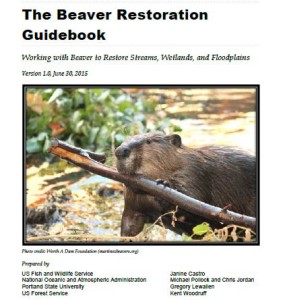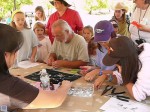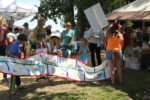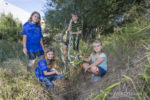Another fourth of July safely passed. We stayed on sight until 9 and the beavers and kits wisely stayed upstream. Except for Junior who went down to the dam when everyone was on the bridge and demonstrated damming behavior. There must have been 100 separate photos taken of him as people stopped to watch on the way to the fireworks. We made sure there were signs for the festival which people remarked on and stopped to look at too. The best thing heard were several comments of “Where else can you see beavers on the way to fireworks?”
No where, I think.
Lots of odds and ends to talk about to day, as my in box has been accumulating. Let’s start with the annoying and work up to the inspirational, okay? The first was reported this weekend in the Sacramento Bee. Remind me never to hire a lawyer or doctor that had such a hard time remembering things in school that he used lies like THIS!
Their video study guides aim to keep it sketchy
 Two video series, dubbed SketchyMedical and SketchyLaw, offer short, animated videos that illustrate biological or legal terms and concepts, using wordplay and nonliteral interpretations of the terms to help students better remember.
Two video series, dubbed SketchyMedical and SketchyLaw, offer short, animated videos that illustrate biological or legal terms and concepts, using wordplay and nonliteral interpretations of the terms to help students better remember.
The 11-video SketchyLaw series on criminal law features animated sketches of beavers chewing on bark to represent the various legal scenarios in felony murder; “BARRK” is the acronym commonly used by law students to remember the five felonies that can lead to a murder charge if someone dies in the process. As the animation progresses, Mueller narrates off-camera to explain the terms.
Beaver in trees so you can remember to watch out for murder charges? Call me a cynic. But I think in this world there are two types of brains. Let’s call them “Bowls” and “Colanders “. And if information is draining out of your head as fast as you put it in, you might be great at making spaghetti, but even if tree-climbing rodents can get you out of law school you won’t remember what your clients tell you anyway! Or what color tie the judge hates, or the best way to start oral argument with a mostly female jury. You get the idea. Law and Med school (and graduate school for that matter) are practice arenas. You have to make it there before you hit the big leagues.
_____________________________________________________
Speaking of the big leagues, there’s a new kid on the beaver management block worth talking about. Jakob Shockey attended the State of the Beaver Conference this year, met with Mike Callahan and others, and decided the watershed group he worked with needed a beaver expert. Folks helped raised funds to send him off to Massachusetts to train with Mike which I wrote about here. Now he’s opened his own shop with website here.
Flow devices can be used in a variety of situations to keep a beaver pond at a certain water level, or to protect a culvert or spillway from damming activity.
Thes e designs essentially trick beaver into believing that their dam is holding water while sneaking it out, either through a caged drainage pipe (pictured) sunk into the middle of the pond or a trapezoidal protective fence.
e designs essentially trick beaver into believing that their dam is holding water while sneaking it out, either through a caged drainage pipe (pictured) sunk into the middle of the pond or a trapezoidal protective fence.
Over time, these solutions are far more cost-effective than lethal management of problem beaver, while also retaining the ecosystem services of beaver on the landscape.
Contact us for more information on a potential solution to your beaver issues.
Welcome to the beaver ‘hood Jakob! It’s wonderful to have another expert on the west coast. We’ll be sure to send lots of folks your way. I already added a link to our blogroll, but let Worth A Dam know if we can help get the word out or maybe with a beaver photo for your cover page. We are happy to assist friends!
_____________________________________________________________
Finally, I received this great paper from beaver friend close to home Jeff Baldwin at Sonoma State. In it he writes deftly about his idea of the way beavers shaped the country. It is a fairly intellectual paper, but you will be smarter at the end of it than you were at the beginning. Jeff already proved himself the intellectual heavy weight of the beaver crowd at the conference, where he thoroughly impressed everyone with his careful capacity to scour the literature and report unpopular truths even to a roomful of acolytes. He’s a brave man, and a very, very smart one.

Beaver as Historical Actors: In Theory and Practice
We now know that beaver dams change landscapes and hydrologies in important ways. Like the milldams on the Appalachian Piedmont they trap sediment. In north central Oregon, Pollack et al. found that in their first year beaver dams trapped enough sediment to raise the stream bed an average of 0.47 meters. Though stream bed aggradation slowed to about 0.075 meters (about 3 inches) in the sixth study year, the area of aggradation broadened significantly as sediment was increasingly deposited across the entire riparian area. Typically, given enough time beaver ponds fill in and become swales and then wet meadows.[4]
Beaver dams essentially spread hydrologic flows across the entire flood plain. The surface of beaver ponds are typically at or near bank-full, meaning that a small increase in flow quickly expands the pond to cover its flood plain. Thus, high stream flows spread nutrients to riparian communities rather than washing them downstream where they have caused hyper-eutrophication and accompanying dead zones. Unlike incised streams whose surface is far below the flood plain and so drain water from the ground below flood plains, beaver ponds charge those soils and aquifers with water. Westbrook et al. explain that typically about one half of the water that flows through a dam-pool system travels through the soil. There it maintains moisture in wide riparian zones long in to dry periods. Typically water re-enters the stream at the temperature of the soil, a cool 54° F (12° C), conditions preferred by many fish species valued by Americans.[5]
Finally, when beaver are present, streams tend to have multiple shallow and shifting channels. For low gradient streams, ‘the model’ that conservationists have been working so hard to emulate bears little resemblance to an ‘un-disturbed stream.’ While one may be impressed with the extent of milldams in Appalachia, that anthropogenic environmental dialectic pales when compared to what beaver did, and still could do, to North American waterscapes. Yet very few historians, environmental historians, or environmental geographers take beaver, and other non-human beings to be historic actors, in and of themselves.
While beaver dams could help mitigate the effects of climate change, they could also help moderate the process. Because ponds are nutrient rich they become eutrophic, and as biota dies and decays anaerobically the ponds and meadows trap the carbon embodied therein. Similarly, the wetland soils around beaver ponds also work to sequester carbon. On a landscape scale, beaver ponds both moderate atmospheric carbon loading, and at local and watershed scales they mitigate increased seasonality. These biospheric relationships would, if allowed, respond in significant, novel, and historical ways to anthropogenic changes to Earth’s atmosphere and climate.[39]
Without the ecology background to inform my reading, I found this paper a little smarter than my brain could process. But I am happy to share it with s better minds than my own. On the most basic level, I am certain that Jeff is right and beavers function as actors on the human landscape and story. I am confident that if we read a little more of Dr. Baldwin we’ll be better equipped for these understandings. Thanks Jeff for your hard work!










 n an elementary school campus? With kids who love the beavers and parents who care? In Washington? So LB and I wrote the principal and media spokesperson for the district, and I posted about it on facebook. Mind you, this is in Kings county which had one of the only websites about flow devices when we were looking for answers back in 2007. Shouldn’t they, of all places, know better?
n an elementary school campus? With kids who love the beavers and parents who care? In Washington? So LB and I wrote the principal and media spokesperson for the district, and I posted about it on facebook. Mind you, this is in Kings county which had one of the only websites about flow devices when we were looking for answers back in 2007. Shouldn’t they, of all places, know better?




































